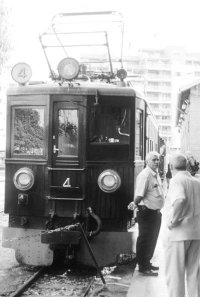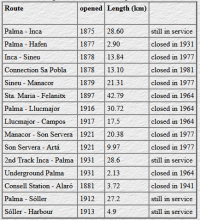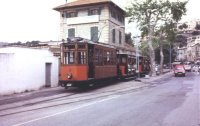Newsletter 1st May 2000
The pictures may take a while to download but have patience - they're worth waiting for !!
I have received an e-mail from Nick Robey (the Old Poblero) about FCM developments at Inca and Sa Pobla - he says "Barry, mixed tidings from the Old Poblero, driving through Inca from the Airport and the railway bridge has gone! Meanwhile, on the Sa Pobla front, it would appear that the re-opening has been put back to 2002 as the railway has encroached on a neighbouring farmer's land by some two metres and legal action is proceeding! I did not get to the new station site, though the old one was visited several times, the SYP (Majorcan supermarket chain) car park is on the old station track formation. There is still much talk of the Alcudia extension, finishing on a brighter note; eleven days later a new bridge is in place in Inca, with much more road space underneath. Hope to be back in S'ubac (Nick's "pied-â-terre" in Majorca) in July, better news then I hope and a bit more free time for walking the line. All the best, The Old Poblero!"
Then came a follow-up message, "Barry, further to my pessimistic report I am now reliably informed that the re-opening will take place in June or July sorry about the other duff info."
and another "as you approach the Sa Pobla turnings coming from Inca on the main Palma - Alcudia road, on the right hand side of the road in a field, backing on to a dry river bed, is what appears to be a four wheeled goods wagon chassis mounted on a concrete plinth. If my memory serves me correctly there is an industrial plant of some kind behind it on the other side of the "torrent", could it have been a tank wagon? I will try to get some pictures of it next time I'm out there, for the opening hopefully! Has anyone else seen it? If you have what do you make of it?" Answers on a postcard (or e-mail), please to The Management in time for next month's newsletter.
On a more serious note, Bob Meaker of Mallorca Highway sent me a page he'd taken from a German-language Majorcan newspaper with an article on the railways of Majorca. It looked so interesting I sent it to Mike Kaben, my partner-in-crime on the website, for translation and he has come up with the following:-
The weekly newspaper Palma Kurier [in German language] published in it's issue of 7th of April 2000 on page 23 in the rubric Country & People this very interesting article, which we reproduce here with the publisher's kind permission:
125 Years Majorcan Railways: The Long Way from the Sidings to Reconstruction Plans
New Government Revives Historic Railways / Extension of Routes to Artá Planned
Today a popular weekend trip: By train into the Tramuntana to Sóller - Photo: Volker Dannenmann
The Majorcans celebrate their railway. Since 125 years it is running on the island. As a birthday gift the Majorcan railway company Serveis Ferroviaris de Mallorca produced a brochure „125 anys del tren a Mallorca“ and an exhibition in the Parc de ses Estacions at the Plaza España.
From Andreas John (translated from German language by Michael Kaben)
Palma - It is running since 1875: The railway between Palma and Inca. By inauguration of their first railway in that year the Majorcans finally - with 50 years delay - arrived in the new age. Already in 1825 in England „Locomotion Nr. 1“ between Darlington and Stockton was invented. Not until half a century later did Europe's industrial revolution come to Majorca in the shape of a steely, driving steam-engine. The island's image changed with each newly opened railway route. Not very much from the golden age of railways has survived until today except for a few abandoned stations. The new government promises: "This will change."
Up to the end of the 19th century 120 kilometres of railway track had been built. They were spread over six routes. The Majorcan railway company - Ferrocarril de Mallorca - opened another five connection routes up to 1931 totalling the same length: 120 kilometres. This included the construction of a second track between Inca and Palma and a tramway of 3 kilometres in length, which led from the capitals centre to the harbour.
Faulty Plan: Donkeys Pull the Train
The steam locomotives were made by manufacturer Terrestre i Marítima in Barcelona. In the year 1929 electricity was introduced and the tram of Palma and the railway to Sóller were changed over to electric traction, the requisite electro-mechanics coming from Siemens in Germany. In 1881 a new railway company was founded: the Ferrocarril de Alaró.
The company operated the unusual track length of 3 kilometres and 720 meters. The reason for the birth of this economical and technical curiosity was a dispute between the community of Alaró, which was the first having electrical power on the island and perhaps laid claim to being progressive, and the community of Consell, whose ground was crossed by the Palma-Inca railway . The Alaroyenses felt cut off from technical progress and built their own railway for the connection to the Estación de Consell. After building they surprisingly discovered that the small steam locomotive was unable to make the incline up to the village lying above so a few donkeys were put before the car, which hauled people and goods to Alaró. To get back downwards, the animals were put into the car and let roll down to Consell.
The Consell-Alaró railway was discontinued on 12th of March 1941 for economical reasons and the first bus line finally put an end to the donkeys' toil. 30 years before, in 1912, the line from Palma to Sóller was inaugurated. Today this railway - only evidence of the great time of railways in Majorca - is a successful tourist attraction. One year later, in 1913, the "Orange-Express" - as the locals love to call the railway to Sóller - was extended by five kilometres to Puerto de Sóller so the fishermen from Puerto Sóller could ride to Palma by train. There, in Majorca's capital, really existed an underground railway at that time. Three kilometres in length the Ramal Subterraneo between the Plaza España and the Porto Pi was opened in 1931. It was used almost exclusively for transport of goods between the harbour and Palma's central railway station.
Mass Tourism Pushes Aside Majorcan Railways
With upcoming mass tourism in the midst of the sixties more and more railway lines disappeared from the Majorcan map. The railway companies increasingly had difficulties to competing against more flexibly operating bus lines and the growing demand for private motor cars. The lines Palma-Santanyí and St. María-Felanitx were closed 1964. In 1977 the connections between Inca and Artá via Manacor finally disappeared. Only the Palma-Inca line is left to the Majorcans until today, but it's profitability is often put in question, too.
The polemics about the construction of a highway in the east of Majorca brought the railway as an alternate transport medium back into discussion. Especially Dr. Pere Brunet from the University of the Balears is known as an advocate for reopening the former railway networks. Already in 1982 Dr. Brunet earned a lot of acknowledgement for his doctoral dissertation about Majorcan railways. Preservation of the old tracks is of great importance to Brunet. "Many route segments cannot be re-activated. The government e.g. would have to expropriate many landowners just for the line Palma-Santanyí or Palma-Felanitx. Only the track from Inca to Artá could be reopened without major problems." Nevertheless the old track routes must not disappear, says Brunet, neither may the accompanying stations, which are going to ruin. "Old railway routes could be changed into hiking and biking ways. This usage of these rutas verdes would leave the way open for a later re-establishment as railway routes. In many countries around the world former railway routes are used as preserved park ways or local recreation areas", Brunet explains.
Change of Government Pulls Train out of Sidings
One of his most ambitious plans is the reactivation of the line Inca-Manacor. "Here one could follow the model of the railway of Sóller. Why not use a refreshed but modernised steam locomotive for traction? This would be an interesting opportunity to get to know the inner island of Majorca for many tourists. Environment as well as traffic would be relieved. And with a clever advertising campaign, much like the private railway company has been doing for decades in Sóller, the neccessary economical investments would quickly return ."
With the change of the government last year the train got new chances to get out of the sidings. The railway connection from Palma via Inca to Manacor, as wished by Brunet, is already planned. It should even be extended to Artá later. The smaller route from Inca to Sa Pobla is already currently under construction. For Pere Brunet and many other Majorcans this development makes a dream become true.
The Majorcan Railways Network
From Chris Meaker in England (we're still not sure if he's a relative of Bob in Majorca) come a number of photos of trains and trams on the Sóller Railway. I haven't included all the photos Chris sent but the first one is particularly interesting to fans of the Sóller Railway because it shows one of the Railway's motor-cars on the Tramway tracks leading down into the town of Soller. I can only assume some form of train re-positioning was being undertaken, using the tramtracks, as the trains don't normally use these tracks and the only other such photograph I have seen is one taken on the inauguration of the Tramway, when a full-size train was taken all the way down to the harbour at Puerto de Sóller and back. The tram in the March 2000 newsletter is positioned on the same stretch of track - click here to go there, use the "back" button on your browser to return here.
I have a LOT MORE of my own photos of the workshops which will eventually appear when I get round to compiling my Sóller Railway pages !!
Tram No. 3 at Puerto de Sóller
STOP PRESS - 29th APRIL 2000
I have just found this on the Saturday April 29th April page of the Majorca Daily Bulletin
More cash rolled out for Majorca railway service
The Balearic government yesterday approved the investment of 1'269 million pesetas into improving Majorca's railway service - which brings the total amount of money spent on Majorca's railway this year to 3'525 million pesetas. The money is to be spent in a wide range of areas from the purchase of new rolling stock and the reformation of stations, including Palma station, to launching viability studies into plans to lay a railway track between Palma centre and the airport, extending the existing Palma to Inca line through Sa Pobla in the heart of the island and on to Alcudia in the north east and linking Palma with the University. What is more, all of the above new lines and extensions should be in operation next year. The investment is seen as a sign of the Balearic government's commitment to improving and supporting the public transport system. The most important project this year is the first phase of the railway line between Palma and Manacor. This year some 2'000 millions pesetas are to be invested in the project, the biggest sum ever spent on Majorca's railway.
That's all for now, folks !! Watch this site for further developments which will take place whenever new information or pictures come to hand. Any submissions of information, photos old or new, postcards, etc., will be gratefully and enthusiastically received and if used on the site will be suitably acknowledged (as above). The photos, pictures and diagrams used on this site are presented for your information and viewing pleasure only. If any of them should be in copyright violation and the copyright holder would care to notify me I will either remove them or acknowledge the copyright accordingly.
Send your messages to Majorcan Railways WebPages
© Barry Emmott 1st May, 2000 minor revisions 13th April, 2009




